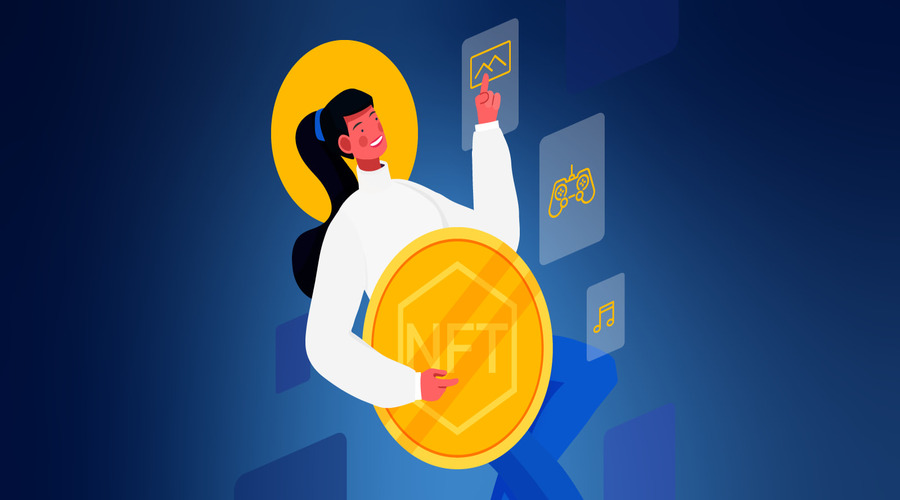In recent years, Non-Fungible Tokens (NFTs) have gained significant popularity, revolutionizing the digital art and collectibles market. NFTs allow for the ownership and trading of unique digital assets, ranging from artwork to virtual real estate. However, the NFT ecosystem is currently fragmented, with various blockchain networks supporting different NFTs. This fragmentation has created challenges when it comes to interoperability and the seamless transfer of NFTs between different chains. In this article, we will explore the concept of cross-chain interoperability in the NFT ecosystem and its implications for artists, collectors, and the broader crypto community.
Understanding Cross-Chain Interoperability
Cross-chain interoperability refers to the ability of different blockchain networks to communicate and exchange assets seamlessly. In the context of NFTs, cross-chain interoperability allows for the transfer of NFTs between different blockchain platforms, enabling increased liquidity and accessibility for artists and collectors.
The Need for Cross-Chain NFT Interoperability
The NFT market has witnessed an explosion of creativity and value, attracting artists and collectors from around the world. However, the lack of cross-chain interoperability limits the potential of NFTs. Artists often face the challenge of choosing a specific blockchain platform to mint and sell their NFTs, resulting in their work being confined to a single chain. Collectors, on the other hand, face the challenge of fragmented markets, needing to hold multiple wallets and navigate various platforms to trade their NFTs.
Challenges in Achieving Cross-Chain Interoperability
Achieving cross-chain NFT interoperability is not without its challenges. Some of the key obstacles include:
- Technical Compatibility: Different blockchain networks have varying technical architectures, consensus mechanisms, and programming languages, making it challenging to establish a standardized framework for cross-chain interoperability.
- Scalability and Performance: Efficient cross-chain communication requires networks to handle a significant volume of transactions and data transfers. Scaling blockchain networks to accommodate increased traffic and maintaining high performance levels are ongoing challenges in achieving seamless cross-chain interoperability.
- Consensus and Governance: Achieving consensus among different blockchain networks with distinct consensus models and governance structures is essential for cross-chain interoperability. Coordinating decision-making processes and aligning interests can be complex, especially when multiple parties are involved.
- Security and Trust: Interoperability introduces additional security considerations. Ensuring the integrity and confidentiality of data transferred between chains, as well as preventing unauthorized access and manipulation, is crucial. Establishing trust among disparate networks and maintaining secure communication channels are paramount.
- Standardization and Adoption: Establishing interoperability standards that are widely adopted across blockchain networks is a significant challenge. Without agreed-upon protocols and frameworks, interoperability solutions can become fragmented and hinder the seamless transfer of assets.
- Interoperability Complexity: Achieving cross-chain interoperability involves designing and implementing complex technical solutions. Building robust bridge protocols, layer 2 solutions, and interoperability frameworks requires significant research, development, and testing efforts.
- Regulatory and Legal Considerations: Different jurisdictions may have varying regulatory frameworks that impact cross-chain interoperability. Compliance with regulations, such as Know Your Customer (KYC) and Anti-Money Laundering (AML) requirements, adds complexity to the interoperability landscape.
- User Experience and Adoption Barriers: Ensuring a smooth user experience when transferring assets across chains is essential for widespread adoption. Overcoming usability challenges, such as wallet compatibility, transaction fees, and learning curves, can influence user acceptance and usage of cross-chain interoperability solutions.
- Community Collaboration: Achieving cross-chain interoperability often requires collaboration among blockchain communities, developers, and stakeholders. Aligning diverse interests, fostering open dialogue, and coordinating efforts can be a challenge, particularly when multiple projects and networks are involved.
- Legacy System Integration: Integrating existing legacy systems with interoperability solutions can present technical hurdles. Legacy systems may not be designed with interoperability in mind, requiring additional work and considerations to bridge the gap between traditional and blockchain-based systems.
- Privacy and Confidentiality: Preserving privacy and confidentiality while enabling cross-chain communication is a challenge. Balancing the transparency and immutability of blockchain with the need for data protection and privacy poses unique challenges in achieving cross-chain interoperability.
- Interoperability Maintenance and Upgrades: As blockchain networks evolve and upgrade, maintaining and upgrading interoperability solutions to remain compatible with the latest network versions can be a continuous effort. Regular maintenance, updates, and coordination among multiple networks are necessary to ensure long-term cross-chain interoperability.
- Education and Awareness: Educating stakeholders, including developers, businesses, and users, about the benefits, challenges, and best practices of cross-chain interoperability is crucial for adoption. Increasing awareness and knowledge about interoperability can foster innovation and collaboration in the blockchain ecosystem.
- Interoperability Cost and Resource Allocation: Implementing and maintaining cross-chain interoperability solutions require dedicated resources and funding. Allocating resources appropriately and ensuring cost-effectiveness is a challenge, particularly for decentralized projects operating with limited budgets.
- Future-proofing and Flexibility: Anticipating and accommodating future changes and developments in blockchain technology is essential for long-term cross-chain interoperability. Designing solutions that can adapt to evolving blockchain standards, protocols, and network upgrades is

Solutions for Cross-Chain NFT Interoperability
Despite the challenges, several solutions have emerged to address cross-chain NFT interoperability:
- Bridge Protocols: Bridge protocols act as intermediaries between different blockchain networks, facilitating the transfer of NFTs between chains. These protocols ensure compatibility and secure transfers through smart contracts.
- Layer 2 Solutions: Layer 2 solutions, such as sidechains and state channels, provide scalability and faster transaction processing. These solutions can enable cross-chain interoperability by bridging multiple chains and reducing reliance on the main blockchain.
- Interoperability Standards: The development of interoperability standards, such as the ERC-1155 standard, allows for the creation of NFTs that can exist on multiple chains simultaneously. These standards provide a framework for cross-chain compatibility and seamless transfers.
- Atomic Swaps: Atomic swaps enable direct peer-to-peer transfers of assets across different blockchain networks without the need for intermediaries. This technology ensures trustless and secure cross-chain transactions.
- Wrapped Tokens: Wrapped tokens represent assets from one blockchain network on another, allowing for their seamless transfer between chains. These wrapped tokens enable cross-chain compatibility and liquidity.
- Cross-Chain Oracles: Cross-chain oracles provide external data feeds and facilitate communication between blockchain networks. They enable the verification of transactions and events happening on different chains, enhancing cross-chain interoperability.
- Governance and Coordination: Establishing collaborative governance models and coordination mechanisms between blockchain networks can facilitate the development and implementation of cross-chain interoperability solutions. This includes promoting open dialogue, standardization efforts, and interoperability-focused collaborations.
- Smart Contract Interoperability: Enabling smart contracts to interact with multiple blockchain networks enhances cross-chain interoperability. Projects such as Polkadot and Cosmos aim to provide frameworks for building interoperable smart contracts.
- Cross-Chain Token Standards: Developing token standards that are compatible with multiple blockchain networks simplifies cross-chain interoperability. These standards allow for the seamless transfer of NFTs between different chains, ensuring compatibility and ease of use.
- Community Collaboration: Encouraging collaboration and knowledge-sharing among blockchain communities, developers, and stakeholders is vital for driving cross-chain interoperability solutions. This includes hackathons, research initiatives, and open-source projects focused on interoperability.
- Interoperability Hubs: Interoperability hubs act as centralized or decentralized platforms that facilitate the exchange and transfer of assets between different chains. These hubs provide a unified interface for users and enhance cross-chain interoperability.
- Research and Development: Continued research and development efforts are necessary to overcome technical challenges and innovate in the field of cross-chain NFT interoperability. This includes exploring new cryptographic techniques, consensus mechanisms, and scalability solutions.
- User Education and Adoption: Educating users about the benefits and functionalities of cross-chain NFT interoperability is crucial for its adoption. Providing user-friendly interfaces, tutorials, and documentation can help onboard more users and drive the adoption of interoperability solutions.
- Regulatory Frameworks: Developing clear regulatory frameworks that address cross-chain interoperability can foster its adoption by providing legal clarity and establishing trust in the ecosystem. Collaboration between blockchain projects and regulatory bodies is essential for creating a conducive environment for cross-chain interoperability.
- Continuous Improvement and Upgrades: Cross-chain interoperability solutions should be regularly updated and improved to adapt to evolving blockchain standards and user requirements. Feedback loops, community engagement, and version upgrades ensure the long-term viability and effectiveness of cross-chain interoperability solutions.
Case Studies: Successful Cross-Chain NFT Projects
Several projects have successfully implemented cross-chain NFT interoperability. One notable example is the collaboration between Ethereum and Binance Smart Chain (BSC) through bridge protocols. This partnership allows for the transfer of NFTs between the two chains, expanding the market reach for artists and collectors.
Future Prospects and Adoption
As blockchain technology continues to evolve, the future prospects for cross-chain NFT interoperability look promising. The development of advanced bridge protocols, layer 2 solutions, and interoperability standards will pave the way for a more connected and accessible NFT ecosystem.
The Impact of Cross-Chain Interoperability on the NFT Market
Cross-chain interoperability has the potential to revolutionize the NFT market by increasing liquidity, expanding market reach, and simplifying the trading process. Artists will have the freedom to mint and sell their NFTs on different chains, reaching a larger audience. Collectors will enjoy greater flexibility and liquidity, as they can trade their NFTs across various platforms.
Conclusion
Cross-chain interoperability is a crucial step towards realizing the full potential of the NFT ecosystem. By breaking down the barriers between blockchain networks, artists and collectors can benefit from increased liquidity, accessibility, and market reach. As the technology continues to advance, we can expect more innovative solutions and collaborations to emerge, shaping the future of cross-chain NFT interoperability.
FAQs
1. Can I transfer an NFT from Ethereum to a different blockchain?
Yes, with the help of bridge protocols and interoperability standards, it is possible to transfer NFTs between different blockchain networks, including Ethereum and other compatible chains.
2. Will cross-chain interoperability affect the value of NFTs?
Cross-chain interoperability has the potential to increase the value of NFTs by expanding the market reach and accessibility. However, the value of individual NFTs will still depend on factors such as scarcity, demand, and the artist’s reputation.
3. Are there any risks associated with cross-chain NFT transfers?
While efforts are made to ensure secure cross-chain transfers, there are inherent risks involved, such as smart contract vulnerabilities and potential network attacks. It is essential to conduct due diligence and use trusted platforms when engaging in cross-chain NFT transfers.
4. How does cross-chain interoperability benefit artists?
Cross-chain interoperability benefits artists by allowing them to reach a broader audience, access multiple markets, and increase the liquidity of their NFTs. Artists can choose the blockchain platform that best suits their needs without being limited to a single chain.
5. Can I trade NFTs across different platforms without cross-chain interoperability?
Currently, trading NFTs across different platforms without cross-chain interoperability requires manual processes, such as withdrawing from one platform and depositing into another. Cross-chain interoperability simplifies and streamlines the trading process by enabling direct transfers between chains.





